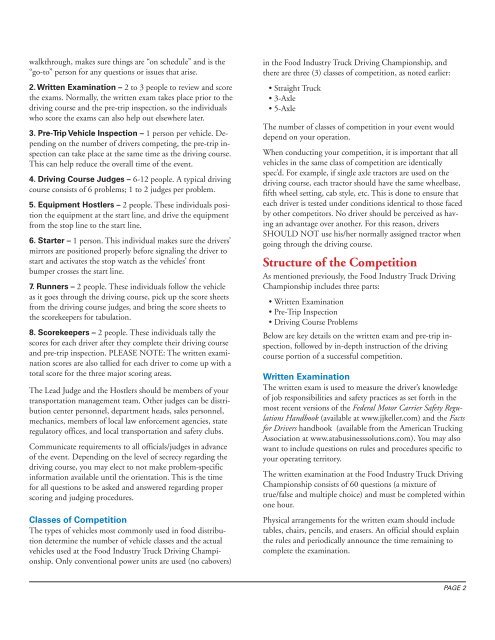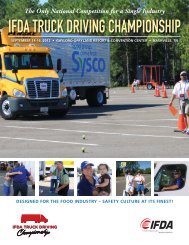Guide to Coordinating a Successful Truck Driving Competition - IFDA
Guide to Coordinating a Successful Truck Driving Competition - IFDA
Guide to Coordinating a Successful Truck Driving Competition - IFDA
You also want an ePaper? Increase the reach of your titles
YUMPU automatically turns print PDFs into web optimized ePapers that Google loves.
walkthrough, makes sure things are “on schedule” and is the<br />
“go-<strong>to</strong>” person for any questions or issues that arise.<br />
2. Written Examination – 2 <strong>to</strong> 3 people <strong>to</strong> review and score<br />
the exams. Normally, the written exam takes place prior <strong>to</strong> the<br />
driving course and the pre-trip inspection, so the individuals<br />
who score the exams can also help out elsewhere later.<br />
3. Pre-Trip Vehicle Inspection – 1 person per vehicle. Depending<br />
on the number of drivers competing, the pre-trip inspection<br />
can take place at the same time as the driving course.<br />
This can help reduce the overall time of the event.<br />
4. <strong>Driving</strong> Course Judges – 6-12 people. A typical driving<br />
course consists of 6 problems; 1 <strong>to</strong> 2 judges per problem.<br />
5. Equipment Hostlers – 2 people. These individuals position<br />
the equipment at the start line, and drive the equipment<br />
from the s<strong>to</strong>p line <strong>to</strong> the start line.<br />
6. Starter – 1 person. This individual makes sure the drivers’<br />
mirrors are positioned properly before signaling the driver <strong>to</strong><br />
start and activates the s<strong>to</strong>p watch as the vehicles’ front<br />
bumper crosses the start line.<br />
7. Runners – 2 people. These individuals follow the vehicle<br />
as it goes through the driving course, pick up the score sheets<br />
from the driving course judges, and bring the score sheets <strong>to</strong><br />
the scorekeepers for tabulation.<br />
8. Scorekeepers – 2 people. These individuals tally the<br />
scores for each driver after they complete their driving course<br />
and pre-trip inspection. PLEASE NOTE: The written examination<br />
scores are also tallied for each driver <strong>to</strong> come up with a<br />
<strong>to</strong>tal score for the three major scoring areas.<br />
The Lead Judge and the Hostlers should be members of your<br />
transportation management team. Other judges can be distribution<br />
center personnel, department heads, sales personnel,<br />
mechanics, members of local law enforcement agencies, state<br />
regula<strong>to</strong>ry offices, and local transportation and safety clubs.<br />
Communicate requirements <strong>to</strong> all officials/judges in advance<br />
of the event. Depending on the level of secrecy regarding the<br />
driving course, you may elect <strong>to</strong> not make problem-specific<br />
information available until the orientation. This is the time<br />
for all questions <strong>to</strong> be asked and answered regarding proper<br />
scoring and judging procedures.<br />
Classes of <strong>Competition</strong><br />
The types of vehicles most commonly used in food distribution<br />
determine the number of vehicle classes and the actual<br />
vehicles used at the Food Industry <strong>Truck</strong> <strong>Driving</strong> Championship.<br />
Only conventional power units are used (no cabovers)<br />
in the Food Industry <strong>Truck</strong> <strong>Driving</strong> Championship, and<br />
there are three (3) classes of competition, as noted earlier:<br />
• Straight <strong>Truck</strong><br />
• 3-Axle<br />
• 5-Axle<br />
The number of classes of competition in your event would<br />
depend on your operation.<br />
When conducting your competition, it is important that all<br />
vehicles in the same class of competition are identically<br />
spec’d. For example, if single axle trac<strong>to</strong>rs are used on the<br />
driving course, each trac<strong>to</strong>r should have the same wheelbase,<br />
fifth wheel setting, cab style, etc. This is done <strong>to</strong> ensure that<br />
each driver is tested under conditions identical <strong>to</strong> those faced<br />
by other competi<strong>to</strong>rs. No driver should be perceived as having<br />
an advantage over another. For this reason, drivers<br />
SHOULD NOT use his/her normally assigned trac<strong>to</strong>r when<br />
going through the driving course.<br />
Structure of the <strong>Competition</strong><br />
As mentioned previously, the Food Industry <strong>Truck</strong> <strong>Driving</strong><br />
Championship includes three parts:<br />
• Written Examination<br />
• Pre-Trip Inspection<br />
• <strong>Driving</strong> Course Problems<br />
Below are key details on the written exam and pre-trip inspection,<br />
followed by in-depth instruction of the driving<br />
course portion of a successful competition.<br />
Written Examination<br />
The written exam is used <strong>to</strong> measure the driver’s knowledge<br />
of job responsibilities and safety practices as set forth in the<br />
most recent versions of the Federal Mo<strong>to</strong>r Carrier Safety Regulations<br />
Handbook (available at www.jjkeller.com) and the Facts<br />
for Drivers handbook (available from the American <strong>Truck</strong>ing<br />
Association at www.atabusinesssolutions.com). You may also<br />
want <strong>to</strong> include questions on rules and procedures specific <strong>to</strong><br />
your operating terri<strong>to</strong>ry.<br />
The written examination at the Food Industry <strong>Truck</strong> <strong>Driving</strong><br />
Championship consists of 60 questions (a mixture of<br />
true/false and multiple choice) and must be completed within<br />
one hour.<br />
Physical arrangements for the written exam should include<br />
tables, chairs, pencils, and erasers. An official should explain<br />
the rules and periodically announce the time remaining <strong>to</strong><br />
complete the examination.<br />
PAGE 2







